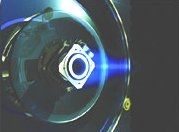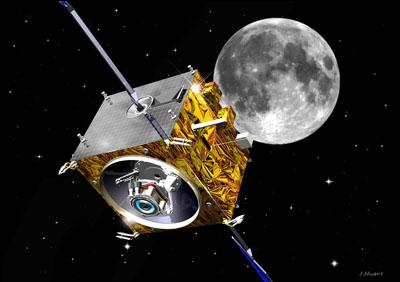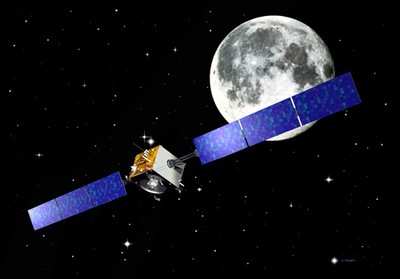To The Moon, Mon Ami! To The Moon!
 ESA’s SMART-1 is successfully
making its first orbit of the Moon, a significant milestone for the
first of Europe's Small Missions for Advanced Research in
Technology (SMART) spacecraft.
ESA’s SMART-1 is successfully
making its first orbit of the Moon, a significant milestone for the
first of Europe's Small Missions for Advanced Research in
Technology (SMART) spacecraft.
A complex package of tests on new technologies was successfully
performed during the cruise to the Moon, while the spacecraft was
getting ready for the scientific investigations which will come
next. These technologies pave the way for future planetary
missions.
SMART-1 reached its closest point to the lunar surface so far -
its first "perilune" – at an altitude of about 5000
kilometers at 18:48 Central European Time (CET) on 15 November.
Just hours before that, at 06:24 CET, SMART-1’s
solar-electric propulsion system (or ‘ion engine’) was
started up and is now being fired for the delicate manoeuvre that
will stabilize the spacecraft in lunar orbit.
During this crucial phase, the engine will run almost
continuously for the next four days, and then for a series of
shorter burns, allowing SMART-1 to reach its final operational
orbit by making ever-decreasing loops around the Moon. By about
mid-January, SMART-1 will be orbiting the Moon at altitudes between
300 kilometers (over the lunar south pole) and 3000 kilometers
(over the lunar north pole), beginning its scientific
observations.
The main purpose of the first part of the SMART-1 mission,
concluding with the arrival at the Moon, was to demonstrate new
spacecraft technologies. In particular, the solar-electric
propulsion system was tested over a long spiralling trip to the
Moon of more than 84 million kilometers. This is a distance
comparable to an interplanetary cruise. For the first time ever,
gravity-assist maneuvers, which use the gravitational pull of the
approaching Moon, were performed by an electrically-propelled
spacecraft. The success of this test is important to the prospects
for future interplanetary missions using ion engines.

SMART-1 has demonstrated new techniques for eventually achieving
autonomous spacecraft navigation. The OBAN experiment tested
navigation software on ground computers to determine the exact
position and velocity of the spacecraft using images of celestial
objects taken by the AMIE camera on SMART-1 as references. Once
used on board future spacecraft, the technique demonstrated by OBAN
will allow spacecraft to know where they are in space and how fast
they are moving, limiting the need for intervention by ground
control teams.
SMART-1 also carried out deep-space communication tests, with
the KaTE and RSIS experiments, consisting of testing radio
transmissions at very high frequencies compared to traditional
radio frequencies. Such transmissions will allow the transfer of
ever-increasing volumes of scientific data from future spacecraft.
With the Laser Link experiment, SMART-1 tested the feasibility of
pointing a laser beam from Earth at a spacecraft moving at
deep-space distances for future communication purposes.
During the cruise, to prepare for the lunar science phase,
SMART-1 made preliminary tests on four miniaturized instruments,
which are being used for the first time in space: the AMIE camera,
which has already imaged Earth, the Moon and two total lunar
eclipses from space, the D-CIXS and XSM X-ray instruments, and the
SIR infrared spectrometer.

In all, SMART-1 clocked up 332 orbits around Earth. It fired its
engine 289 times during the cruise phase, operating for a total of
about 3700 hours. Only 59 kilograms of xenon propellant were used
(out of 82 kilograms). Overall, the engine performed extremely
well, enabling the spacecraft to reach the Moon two months earlier
than expected.
The extra fuel available also allowed the mission designers to
significantly reduce the altitude of the final orbit around the
Moon. This closer approach to the surface will be even more
favorable for the science observations that start in January. The
extra fuel will also be used to boost the spacecraft back into a
stable orbit, after six months of operations around the Moon, in
June, if the scientific mission is extended.
 ANN's Daily Aero-Linx (04.16.24)
ANN's Daily Aero-Linx (04.16.24) Aero-News: Quote of the Day (04.16.24)
Aero-News: Quote of the Day (04.16.24) Airborne 04.10.24: SnF24!, A50 Heritage Reveal, HeliCycle!, Montaer MC-01
Airborne 04.10.24: SnF24!, A50 Heritage Reveal, HeliCycle!, Montaer MC-01 Airborne 04.12.24: SnF24!, G100UL Is Here, Holy Micro, Plane Tags
Airborne 04.12.24: SnF24!, G100UL Is Here, Holy Micro, Plane Tags Airborne-Flight Training 04.17.24: Feds Need Controllers, Spirit Delay, Redbird
Airborne-Flight Training 04.17.24: Feds Need Controllers, Spirit Delay, Redbird





